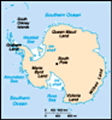Advertisement
Published: February 21st 2019
Wednesday – Monday 13-18 February: DAYS 12 - 17 / SOUTH SHETLAND ISLANDS AND ANTARCTICA PENINSULA
This Blog: Day 12/13, 13&14 February
Around 60 miles off the coast of the Antarctic mainland we found the South Shetland Island chain.
1. Active Sound in the Antarctic Sound
Pushing on past the islands, on Wednesday morning, we woke to the announcement that it was 0.5 C degrees with fine weather. Out our window we saw lots of ice floating in the water and islands around us, some covered in ice and others of dark volcanic treeless peak. It was starkly beautiful.
After breakfast, we rugged up, went outside to take some photos then got ready for a 9.00am launch into the zodiacs.
As the wind was strong, we stayed in the zodiacs in the morning for almost 2 hours, spotting Adelie penguins with their black heads and a white ring around their eyes. Mostly they were perched on top of tall icebergs as they love climbing.
Then there was a shout to announce that the minke whale was spotted. Everyone in our zodiac saw
the whale. Fur seals were also spotted as were crab-eating seals. Several zodiacs even saw a leopard seal but ours didn’t.
Even though the day started a little foggy, again by the time we were wildlife-watching, the sun came out and the water turned a beautiful blue. The older, more compressed icebergs were also brilliant blue with the refraction and reflection of the sun on them.
It was beautiful floating around the Sound, occasionally stopping to watch the Adelie penguins slipping down the ice then climbing up again. Some ice bergs had icicles hanging from them, others had mini caves in their edge surfaces. The shapes and shades were spectacular.
As this was the 1
st zodiac ride in these very cold situations, several of our passengers hadn’t ‘layered-up’ with their clothes so they were getting rather cold by the time we headed back to the ship. Again, I was very toasty except for my camera hand with only one glove on it!!!
When we got back to the ship around 11.00am we were handed a hot chocolate with Bailies. Absolutely perfect. Wow, this ship catered well. It was
a lovely touch.
2. Brown’s Bluff
After lunch our very clever captain and crew weaved their way through the ice sheets. I stood out on the front deck and the way the crew navigated their way between big iceberg and pushed sheets of ice away was fascinating to watch. In the distance we saw a large ocean liner. I was so pleased we weren’t on such a big ship as I am sure passenger wouldn’t have had the continuous access to the ship’s bridge watching how the sailors interacted and worked their ship as we did.
It was touch and go if we were going to be able to land the zodiac due to various conditions but eventually heard that all was possible. The risk was that if the wind sprang up and blew the ice sheets towards the shore the zodiacs could be blocked from getting back to the ships as the ice moves with the tides. If this was the case, it has been known for the zodiacs to be stranded for 8 hours until the tide changed, and the ice sheets moved away from the shore.
All was OK with our part of the expedition, making shore at Brown’s Bluff. It was another ancient volcanic region, but the most exciting aspect was that it was Tom’s and my last world continent to land on, our 7
th Continent. We didn’t realise this until one of the staff asked us all. One English lady had bought her Union Jack flag along to have photos taken with it.
At the Bluff was a colony of Gentoo penguins with one lonely Adelie penguin amongst them. Many of the penguins were moulting. Many of the young were chasing after their parent and eventually convincing them to regurgitate some food for them. It was great to watch. They weren’t afraid to come up to you if you were sitting on the ground to see what we were or to peck at our walking pole or bags. One young one positioned himself between a bloke’s legs and stayed there for 5 minutes or so, perhaps sheltering from the wind.
After an hour or so we hopped back into the zodiacs to return to the ship. The wind had sprung up so some got wet on the
way back but as the over-clothes we were supplied by the company were waterproofing, all was OK. We returned safely back to the ship for another great evening of chatting to some fantastic fellow passengers. What a trip we were having.
After dinner our resident historian continued his stories of living in the Antarctic in the 1960s and the risks and rewards that presented themselves when they had to go through a 9-month winter. Today, people living temporarily in Antarctica are ‘wintered-in’ for only 6 months.
Brown Bluff is a basalt tuya located on the Tabarin Peninsula of northern Antarctica. It formed in the past 1 million years, which erupted subglacially within an englacial lake. The volcano's original diameter is thought to have been about 12-15 kilometers, and probably formed by a single vent. Brown Bluff is subdivided into four stages: pillow volcano, tuff cone, slope failure, and hyaloclastite delta and into five structural units.
Advertisement
Tot: 0.069s; Tpl: 0.012s; cc: 10; qc: 29; dbt: 0.0267s; 1; m:domysql w:travelblog (10.17.0.13); sld: 1;
; mem: 1.1mb



























